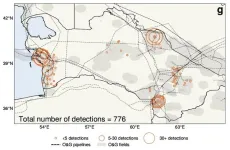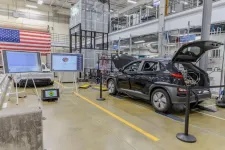(Press-News.org) University of Alaska Fairbanks scientists are developing a new light detection and ranging instrument to help gain a better understanding of space weather enveloping Earth.
The new laser radar, or lidar, will be the third for the UAF Geophysical Institute. It will measure temperature and neutrally charged iron in the upper atmosphere at altitudes of 75 to 125 miles, where the mesosphere and thermosphere meet.
Understanding the processes and influences at that altitude has become increasingly important as the proliferation of low-Earth orbit satellites continues and more nations send probes through the region on their way to the moon and elsewhere.
“The goal is to develop a remotely operated iron lidar to complement the current science investigations with the Geophysical Institute’s two established lidars,” research assistant professor Jintai Li said.
Li leads the science operations at the Lidar Research Laboratory at Poker Flat Research Range, a unit of the Geophysical Institute. He received his Ph.D. in atmospheric sciences from UAF in 2019.
The new lidar is being developed in collaboration with a commercial laser partner and will be placed at the Geophysical Institute’s High-frequency Active Auroral Program facility near Gakona. The new lidar will support experiments at HAARP and provide complementary measurements to Poker Flat’s two lidars — the sodium resonance wind-temperature lidar and the Rayleigh density temperature lidar.
“Lidars employ laser spectroscopy to make measurements of temperatures, densities and winds in the upper atmosphere that cannot be made by other methods,” said Richard Collins, director of the Lidar Research Laboratory.
Collins is an atmospheric sciences professor and also director of the UAF Graduate School.
A lidar uses a pulsed laser beam to resolve and distinguish objects or targets at different distances within a specified range. It is similar to radar but uses light instead of radio waves.
Two types of lidar exist. One detects a hard surface and can create highly detailed 3D maps of terrain, buildings, vegetation and other objects. Another type detects the volume of a target, such as a water body or atmosphere.
With atmospheric lidars, scientists can determine wind speed and direction by analyzing the Doppler shift in the returned signals. The Doppler shift refers to the change in frequency or wavelength of a wave in relation to an observer who is moving relative to the source of the wave.
Temperature can be inferred from the broadening of spectral lines in the laser’s returned light. Broadening is caused by the thermal motion of particles. Hotter areas have faster-moving particles, resulting in broader spectral lines.
Construction on the new lidar, called the iron resonance wind-temperature lidar, began in April 2021. It is funded by a $1.4 million National Science Foundation grant and is expected to be operational later this year.
The lidar will measure neutrally charged iron atoms rather than the molecules of the atmosphere itself. The color of the lidar light is precisely tuned to give a strong echo from the iron atoms.
“The trick is to select the right laser color so that the iron atoms embedded in the air give us enough returned signal to work with,” Li said.
Meteoroids, and especially micrometeoroids, continually bombard Earth’s atmosphere and deposit iron and other elements into the mesosphere and thermosphere as they burn up at the edge of space.
While there are several metals deposited by meteors, recent studies have shown the iron layer extends to higher altitudes. This means lidar measurements can be obtained deeper into the space weather region.
At HAARP, the new lidar will help scientists study a variety of occurrences and interactions that require both radar and lidar. Among them is the interaction between dusty space plasmas and polar mesospheric clouds, also called noctilucent clouds.
Noctilucent clouds consist of tiny ice crystals and appear as thin and electric blue clouds that can sometimes be seen shining in the night sky during the summer months at high latitudes. Dusty space plasmas are regions of space where charged particles — plasma — and solid particles of dust coexist.
Dusty space plasmas can affect Earth’s upper mesosphere by introducing particles that can lead to changes in atmospheric chemistry. Changes to the mesosphere can influence the formation, distribution and duration of noctilucent clouds.
CONTACTS:
• Jintai Li, University of Alaska Fairbanks Geophysical Institute, jli23@alaska.edu.
• Rod Boyce, University of Alaska Fairbanks Geophysical Institute, 907-474-7185, rcboyce@alaska.edu
END
New UAF lidar will add to space weather research capability
2024-03-12
ELSE PRESS RELEASES FROM THIS DATE:
A simple and robust experimental process for protein engineering
2024-03-12
Image
A protein engineering method using simple, cost-effective experiments and machine learning models can predict which proteins will be effective for a given purpose, according to a new study by University of Michigan researchers.
The method has far-reaching potential to assemble proteins and peptides for applications from industry tools to therapeutics. For instance, this technique can help speed up the development of stabilized peptides for treating diseases in ways that current medicines can't, including improving how exclusively antibodies bind to their targets in immunotherapy.
"The rules that govern how proteins work, from sequence to structure to function, are ...
UTEP researchers to design movement-based training to support local health providers
2024-03-12
EL PASO, Texas (Mar. 12, 2024) – Burnout among health care workers is a well-documented problem that can exacerbate health disparities and limit access to care. Now, researchers at The University of Texas at El Paso are taking a creative approach in their search for a solution – a training program for providers that combines elements of art and science.
The project will examine the impact of a movement-based and somatics cross-training intervention on health care providers in the Paso del ...
Alaska dinosaur tracks reveal a lush, wet environment
2024-03-12
A large find of dinosaur tracks and fossilized plants and tree stumps in far northwestern Alaska provides new information about the climate and movement of animals near the time when they began traveling between the Asian and North American continents roughly 100 million years ago.
The findings by an international team of scientists led by paleontologist Anthony Fiorillo were published Jan. 30 in the journal Geosciences. Fiorillo researched in Alaska while at Southern Methodist University. He is now executive director of the New Mexico Museum of Natural History and Science.
University ...
Study: Best way to memorize stuff? It depends...
2024-03-12
Recent experiments by psychologists at Temple University and the University of Pittsburgh shed new light on how we learn and how we remember our real-world experiences.
The research, described in the March 12 online edition of Proceedings of the National Academy of Sciences (PNAS), suggests that varying what we study and spacing out our learning over time can both be helpful for memory — it just depends on what we’re trying to remember.
“Lots of prior research has shown that learning and ...
Exploring arctic plants and lichens: An important conservation baseline for Nunavut’s newest and largest territorial park
2024-03-12
Encompassing over 16 000 km2 of towering mountains, long fiords, lush valleys, and massive ice caps, Agguttinni Territorial Park is a protected area on northern Baffin Island, Nunavut, Canada. This park, and all of Nunavut, is Inuit Nunangat – Inuit homeland in Canada – and the park protects sites and biodiversity stewarded by Inuit since time immemorial.
Agguttinni means “where the prevailing wind occurs” in the Inuktitut local dialect. The park includes important bird areas, key habitats for polar bears and caribou, and numerous important Inuit cultural sites. It is very remote: no roads lead to it, and access ...
Multiple organ attack and immune dysregulation: Study reveals how the chikungunya virus leads to death
2024-03-12
The chikungunya virus, transmitted by Aedes aegypti and Aedes albopictus mosquitoes and responsible for more than 900 deaths in Brazil since it arrived around ten years ago, is capable of spreading through the blood, reaching multiple organs and crossing the blood-brain barrier, which protects the central nervous system. The mechanisms of action observed for the first time in fatal cases by a group of Brazilian, American and British researchers were reported in an article published on March 12 in the journal Cell Host & Microbe. The findings reinforce the need ...
Setting realistic expectations for recovery after robotic lung surgery
2024-03-12
Are surgeons giving patients unrealistic expectations about recovery after robotic lung surgery? That’s what CU Department of Surgery faculty member Robert Meguid, M.D., MPH, and surgery resident Adam Dyas, M.D., set out to discover after realizing the guidance they were offering patients might be based on outdated or anecdotal information.
“Traditionally, in surgery, we're taught to tell patients that they'll be back to normal from surgery within six weeks,” says Meguid, professor of cardiothoracic ...
UCF researchers lead $1.5 million project to improve efficiency of solar cells
2024-03-12
ORLANDO – A team of researchers from the University of Central Florida and the University of Delaware’s Institute of Energy Conversion has received a $1.5 million grant from the U.S. Department of Energy Solar Technologies Office to develop a novel metallization process that could improve the efficiency and lower the cost of solar cells, making solar energy more accessible to consumers.
The metallization process produces the metal contacts that are placed on the surface of silicon solar cells to ...
AI analysis of historical satellite images show USSR collapse in 1990s increased methane emissions, despite lower oil and gas production
2024-03-12
The collapse of the former Soviet Union in 1991 had social, political and economic effects worldwide. Among them was a suspected role in slowing human-generated methane emissions. Methane had been rising steadily in the atmosphere until about 1990. Atmospheric scientists theorized that economic collapse in the former USSR led to less oil and gas production, and thus a slowdown in the rise of global methane levels, which has since resumed.
But new University of Washington research uses early satellite records to dispute that assumption. The study, published March 12 in the ...
Charging up the commute
2024-03-12
A team of researchers at Oak Ridge National Laboratory demonstrated that a light-duty passenger electric vehicle can be wirelessly charged at 100-kW with 96% efficiency using polyphase electromagnetic coupling coils with rotating magnetic fields.
ORNL’s patented system transferred power to a Hyundai Kona EV across a five-inch airgap using electromagnetic fields, a process similar to the wireless charging of small consumer devices.
“We’ve achieved the highest power density in the world for a wireless charging system for this class of vehicle,” ORNL’s Omer Onar said. “Our ...



